DeSci是一场革命?还是一场梦?
虽然 DeSci 可能不会彻底改变整个科学生态系统,但它可以逐步通过发现其价值的研究人员和用户来扩展。最终,我们可能会看到 TradSci 和 DeSci 之间的平衡。
 JinseFinance
JinseFinance
Author: Michaellwy, author of Blockcrunch; Translation: Golden Finance xiaozou
The cross-chain Arbitrary Message Passing (AMP) protocol is an interoperability solution that supports any data block (including tokens, chain state, contract calls, The transfer of NFTs or governance votes) from chain A to chain B.
Axelar, LayerZero and Wormhole are the three most well-known span The chain AMP protocol all has the characteristics of external verification. This means that their cross-chain transactions are verified by a third party that is not part of the blockchain in question. While there are other verification types for cross-chain bridging, such as native verification methods (such as L2 rollup and Cosmos IBC) and local verification methods (such as Connext), our focus is on understanding these external verification AMP protocols.
Considering that they all use external verification, what are the specific differences between these three protocols? The answer lies in their trust mechanisms. We can divide external verification protocols into three categories according to different trust mechanisms: trust pledge holders (humans), trust economics/game theory, and trust mathematics/code.
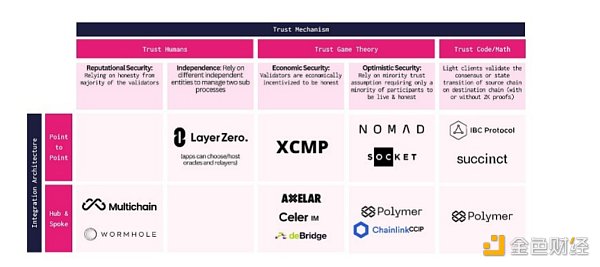
· Trust the stake holder (human): This method relies on the reputation of a specific entity to validate transactions.
· Trust Economics/Game Theory: The verifier acts with integrity in order not to face the risk of losing collateral. The idea is that the financial losses caused by the misconduct will outweigh any illegal gains.
· Trust Math/Code: Use zero-knowledge technology and concise proofs before transferring assets to other chains On-chain light client verification method to verify the status of a certain chain.
LayerZero and Wormhole both belong to the category of "trust pledge holders". Let's take a brief look at their mechanisms:
· LayerZero uses two types of validators (validators/devices): "Oracle" and "Relayer". An Oracle is essentially a contract address that can be notified to transfer a block header. It transmits block header information from the source network to the destination network. Relayer submits message validity certificate based on the block header provided by Oracle. Only when Oracle and Relayer both confirm the accuracy of a message, the message is considered valid.
· Wormhole uses a Proof of Authority (PoA) model, and its security depends on a group of people called "Guardians" (19) external validators. Guardians observe the information and sign the corresponding payload. Each Guardian performs this step independently and then forms a multi-signature, which is proof that a certain state has been observed and confirmed. Acting as Guardians are well-known companies such as Figment, Everstake, ChainLayer and Certus One.
In contrast, Axelar is different from the other two in terms of trust mechanism:
· Axelar uses the Cosmos SDK to run a delegated proof-of-stake (PoS) mechanism and uses cryptoeconomics to ensure security. It has a permissionless validator set of 75 validators coordinated through Tendermint. Validators are incentivized by block rewards to act with integrity, and will face penalties for illegal operations or prolonged downtime. The reliability of the protocol is supported by the financial commitment of the validator and the governance mechanisms established within the protocol. Axelar validator also uses the Threshold Signature Scheme (TSS) to jointly maintain accounts on each blockchain.
A simple summary is:
· LayerZero: Trust is placed on the two entities running Relayer and Oracle.
· Wormhole: Trust is placed in approximately 19 authorized Guardians.
· Axelar: Trust is placed on the economic guarantee of 75 validator pledges.
(1 ) Axelar stands out as the cross-chain protocol with the highest degree of trust minimization
From the above content, we can already See how Axelar stands out because it has the lowest level of trust requirements. Let’s compare the architecture of Axelar, LayerZero, and Wormhole in more detail.
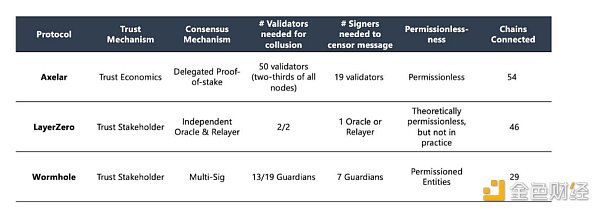
LayerZero's architecture revolves around "Oracle" and "Relayer". Oracle gets the block header (digest of the block) from chain A and sends it to chain B for mutual state verification. In theory this is permissionless and anyone can become an Oracle. Currently, the default is Google Oracle, with another option being Chainlink. Relayer provides proof of events on chain A as the basis for chain B’s behavior. Importantly, the Relayer is responsible for ensuring security and execution. In theory, Relayer is permissionless and anyone can run Relayer, but in reality it is operated by LayerZero.
This is why LayerZero's architecture is sometimes derided as"2/2Multi-Sign ”. The integrity of the bridge depends on the independence of Oracles and Relayers, which can retain data to review messages. Although LayerZero allows customizing Oracle and Relayer settings, in practice setting up personal Oracles and Relayers is very challenging and expensive, so few people do it. This introduces limitations in security, liveness, and censorship resistance as the default configuration relies on trusting several entities.
Wormhole uses an authoritative proof model, which is more decentralized than LayerZero, but still requires permission. It relies on 19 "Guardians" from authorized entities. When 13 out of 19 validators agree, the cross-chain message is considered valid. The protocol includes a "Govenor" feature that pauses large transactions, adding an extra layer of security. However, the involvement of entities like former validator FTX shows the potential risks of relying solely on reputational trust.
Axelar's trust approach is unique, relying on the economic guarantee of a network of 75 active validators to provide a higher degree of decentralization. In the case where a few people dominate the PoS system, the quadratic voting adopted by Axlear plays a crucial role in maintaining decentralized decision-making.
Usually, blockchain governance operates on the principle of "one token corresponds to one vote", where voting rights increase linearly with the increase in token holdings. . However, Axelar’s quadratic voting mechanism increases the cost of each additional vote, effectively curbing the concentration of power and encouraging a more balanced distribution of influence.
The protocol requires the entire validator set to reach at least 60% consensus in order to verify cross-chain messages. This threshold ensures that the validity of a message does not depend on the size of a specific subset of validators serving a specific chain.
In addition, in order to enhance the security of the network, Axelar has also developed a speed limit function. By placing a cap on the total value of assets that can be transferred on Axelar at a given time, the network effectively minimizes any potential losses from unforeseen events. Axelar's application-level security add-on also allows developers to custom create security rules. For example, DeFi applications can set specific limits on fund transfers, transaction frequency, and large transfers.
(2)Hub & Spoke (spoke) extension model is better than point-to-point model
Axelar’s cross-chain architecture adopts Hub & Spoke network topology. This is significantly different from LayerZero's point-to-point design.
Let’s think of cross-chain messaging like an airline’s flight system: just like a long-distance flight passes through a central airport in a big city, Axelar passes it through a central platform - Axelar PoS chain - to deliver messages and transactions. This approach reduces the number of connections to operate, simplifies monitoring, and is easier to upgrade.
Another way of thinking is to think of Layer Zero as a two-way radio that can establish a direct connection between two users. In contrast, Axelar operates more like a cellular network, with communications sent to different endpoints through cell towers (representing hubs). This is reflected in its adaptability and configurability.
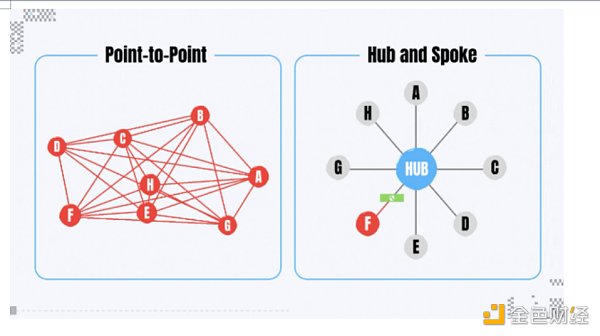
In the Hub & Spoke model, we can see that the network connection is more "neat". But beyond the “tidyness” of your organization, it’s also about cost-effectiveness and effective management. In fact, we can see that in the real world, many systems adopt the hub and spoke model:
· Health care network: central hospital (hub) Specialized services such as trauma care are provided, while local clinics (spokes) provide basic care and diagnosis. This setup ensures centralized efficiency for professional services, while basic needs are available locally.
· Library system: the main library (hub) holds extensive collections and resources, while local branch libraries (spokes) serve the specific needs of the community , ensuring that professional resources can be widely accessed.
· Foreign policy: After World War II, the United States’ foreign policy in East Asia adopted the “Hub & Spoke” model alliance system. In the bilateral alliance network, the United States is the central "hub" and other countries are the "spokes".
Another advantage is that the central hub can improve efficiency in times of crisis. In peer-to-peer networks, isolated connections may not simultaneously detect risks. Axelar reduces this risk by centralizing interactions, thereby enhancing network security and responsiveness. For example, when Multichain, another bridge protocol, was disrupted by the detention of its founder, a cross-chain exchange service built with Axelar was able to maintain security and liquidity by isolating problematic connections.
The most obvious criticism of the Hub & Spoke model is its centralization risk: if the hub fails, the entire network will be damaged. In Packy McCormick’s in-depth research on LayerZero, LayerZero founder Bryan pointed out:
(For cross-chain protocols) there is an intermediate chain—— Cosmos, Axelar, Wormhole or other —— to listen for events and perform validity checks "Yes/No" is judged and the message is sent. Everyone trusts the role of the middleman. Once there is a problem with the middleman, it will affect all blocks related to it.
The key here is that in a cross-chain network, central components are inevitable. Although LayerZero emphasizes direct two-way communication, it still relies on some form of "middleman" role. Axelar recognized that forcing otherwise non-interoperable blockchains into this role was a fundamental flaw in peer-to-peer systems. 0xpostman sums this up well:
The core idea here is that in a peer-to-peer system, connected L1 blockchains In fact, it is hubs. Most blockchains are not designed to be interoperability hubs, and using them in this way is a mistake.
Another advantage of the Hub & Spoke model is its scalability. In a network composed of "n" nodes, only "n-1" routes can connect all nodes in the Hub & Spoke system. For example, a system with 10 nodes only needs 9 routes to connect all the points. In contrast, a point-to-point system with the same number of nodes would require 45 routes to be fully connected. As we anticipate the proliferation of L1, rollup, and application chains in the future (a state of “hundreds of chains blooming”), the limitations of this peer-to-peer model become more apparent.
(3)AxelarVirtual machine (AVM) will promote cross- ChainDappDevelopment
Axelar Virtual Machine (AVM) is developed based on Cosmwasm, transforming interoperability into a programmable layer. It enables developers to write smart contracts directly on Axelar to expand their cross-chain projects, while abstracting cross-chain tasks (such as token exchange) to reduce developer burden. AVM has the following features and functions:
· Permissionless connection to new chains: AVM supports permissionless connections to new chains and supports the integration of new blockchains Automation of required technical overhead. This feature, called Interchain Amplifier, simplifies the process of supporting new chains by incentivizing validators to aggregate AXL tokens through third-party sources.
· Interchain Maestro : This tool enables developers to deploy and manage multi-chain dApp instances. Interchain Maestro’s “build once, run anywhere” philosophy simplifies the development process. A recent update indicated that the Interchain Token Service (ITS) will be launched on the testnet in July. ITS scales the token across chains while maintaining its native properties, providing teams with an easy way to mint tokens and manage supply and functionality.
So what does this term mean? Is there anything real that can be created? Ben Weinberg from Axelar provided some ideas on a community forum:
· Cross-chain liquidity: Distribute liquidity across chains to enhance smaller Network mobility.
· Cross-chain revenue optimization: DeFi protocols across multiple chains maximize revenue opportunities.
· Cross-chain pledge: pledge across multiple blockchains.
· Universal wallet: Create a wallet with a unified token balance that can actually operate across chains.
· Cross-chain market: Build an NFT market that integrates multiple blockchains.
Axelar with AVM is well-positioned to support the transition to cross-chain applications, where applications are designed to run seamlessly across multiple chains, breaking silos Network barriers. In fact, we have already seen some examples of this:
· Sommelier is a multi-chain yield developed based on the Cosmos SDK vault, and bridges high-value EVM networks. Its vaults dynamically adjust based on market conditions or set indicators, resulting in more adaptive and profitable strategies. Sommelier leverages Axelar to bridge other EVMs, allowing interaction with smart contracts in their native environment to perform rebalancing.
· Ojo is a cross-chain Oracle network built on the Cosmos SDK, using Tendermint BFT to achieve consensus, specifically for coming from and going Centralized aggregation and dissemination of data across blockchain sources. Validators on Ojo can proactively provide approved data sources and be rewarded for their contributions. Ojo leverages Axelar’s cross-chain smart contracts and IBC protocol to efficiently deliver pricing information. Validators provide real-time data on asset prices, which is aggregated and verified on-chain.
(4)LayerZero v2 shows that Axelar is real< strong>“layer 0”
The name LayerZero can be said to have come from a marketing genius handwriting. It expresses the Layer 0 (L0) concept of blockchain - conveying the meaning of the interoperability layer running under the L1 blockchain. However, the name itself does not define the function. Although the name is LayerZero, its functions are more reflected in the application level in the field of interoperability, while Axelar, although it cannot be seen from the name, is closer to the true essence of the Layer 0 protocol. This has become even more apparent with the recently released LayerZero v2.
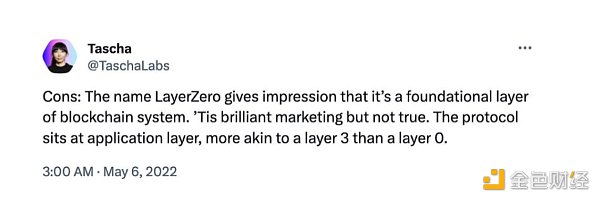
Let's take a look at Not Boring's specific comparative analysis of LayerZero and TCP/IP protocols:
“If TCP/IP is the enabling protocol of the Internet, I think LayerZero can become the full chain (Omnichain) Enabling the protocol, the full chain is a blockchain network in which all blockchains have their own points of differentiation.”
If we look carefully, we will find that in the TCP/IP model, there are still different functions. TCP/IP is a layered server architecture system in which each part is defined according to a specific function. All four layers work together to transfer data from one layer to another.

· Application layer: As the topmost layer, the application layer is where user interaction and data are generated. The protocols it contains include SMTP protocol for email, HTTP/HTTPS protocol for web browsing, and FTP protocol for file transfer, etc.
· Transport layer: This layer establishes reliable and error-free connections. It breaks data into packets and directs and coordinates their precise delivery in order.
· Internet layer: Also called the IP layer, its main function is to transmit data packets and routes throughout the network. It utilizes protocols like IPv4/IPv6 for data routing between various networks.
· Network access layer: This layer corresponds to the data link layer and physical layer of the OSI model. It focuses on the physical aspects of data transfer, handling tasks such as MAC addressing and management of Ethernet cables, wireless networks, network interface cards, and drivers.
LayerZero is designed to run primarily at the application layer or transport layer, more like a wrapper on top of existing protocols. Continuing to quote Not Boring:
“ LayerZero is only the transport layer, and Wormhole is also only a verification layer. Therefore, Uniswap can replace Chainlink with its own validator set. As far as Wormhole is concerned, If you want to do this, you also need to use its 13/19 Guardian model. ”
"We feel that the Uniswap forum is more of a failure in properly communicating the protocol and its role, "Bryan tell me. "They want us to be Wormhole or Axelar, but we are anything but. "
In the newly announced LayerZero v2, one of the most important changes is that Oracle and Relayer are replaced by "Decentralized Validator Network" (DVN) and "Executor", which are Permissionless:
" Now any external network can become a DVN and applications can choose Any combination of them to approve the message. When publishing, Animoca, Blockdaemon, Delegate, Gitcoin , Nethermind, Obol, P2P, StableLab, Switchboard, Tapioca , SuperDuper, Polyhedra and Google Cloud are confirmed DVN options and have been built Adapter to connect Axelar and Chainlink's CCIP. The roadmap also includes other bridges (includingWormhole ) adapter.”
Crucial to Axelar’s functionality is the security provided by its validator node - The platform uses an intermediate consensus layer. This layer sets a common standard for consensus for all Axelar messaging, unlike LayerZero’s approach, which leaves the rules and consensus definition to individual dApps. Axelar provides a structured framework for messaging, while LayerZero provides greater flexibility for dApps.
Chia Jeng Yang (from Pantera) describes this succinctly in his blog post:
LayerZero does not specify the complete security profile that multi-chain dapp will use, but adopts a modular approach that allows dapp Deciding how secure you want to design and implement puts the burden of security design choices on the developer.
LayerZero is "thinking about security without thinking about security", while Axelar is about all layers - including network, service and infrastructure layers ( Such as relay and gas services) - value capture opens up many opportunities. LayerZero does not control the bottom layer.
This is another way to look at interoperability protocols through the lens of modularity. Similar to the modular blockchain theory, the functions of the blockchain are divided into execution layer, settlement layer, consensus layer and data availability layer. We can also divide the cross-chain protocol into modular blocks serving each function:
· Application: interpret data in standard mode
· Transfer: transfer data Moving from one domain to another
· Validation: ensuring the validity of the data passed
It is not difficult to see that the most critical part here is the verification part, which refers to the process of ensuring that the information about the status received by chain A and chain B corresponds to the confirmed valid status of each chain. This is crucial when two chains take actions based on each other's state. As far as LayerZero v2 is concerned, this part is basically outsourced to other entities. Axelar provides a reliable network to serve the verification layer.
(5)Wormhole Gatewayproves the merits of the Axelar architecture< /p>
We have discussed a lot about LayerZero, but what about Wormhole? It’s valued at $2.5 billion in private markets and has a strong presence among Move-based chains like Solana and Sui/Aptos, so how does it compare to Axelar?
Wormhole has similarities to Axelar, especially in the Hub & Spoke model. If we continue with the modular interoperability protocol example, Wormhole also operates at the validation layer, providing true consensus. While their trust mechanisms differ — Wormhole relies on the reputation of Guardians, while Axelar relies on economic staking — they differ primarily in their ecosystem focus and business strategies.
Wormhole focuses on bridging the EVM and Solana ecosystem, while Axelar, as a Cosmos chain, is more focused on the Cosmos ecosystem. Notably, both Wormhole and Axelar were approved for use by Uniswap Governance in its Deep Bridging Assessment report. (Note: Due to concerns about centralization, LayerZero was not approved).
But what is very interesting is that Wormhole recently announced Wormhole Gateway. Let’s take a look at the specific content:
“Wormhole Gateway is in CosmosAn application-specific blockchain developed in the ecosystem, serving as a bridge connecting multiple Cosmos chains and applications through a single cross-chain liquidity router.”
Sound familiar? Doesn't this sound like Axelar in practice? Wormhole has decided to launch its own chain called Gateway using the Cosmos SDK, which will enable users to access over 23 blockchains through an IBC-based liquidity router. It also acts as a sovereign verification layer for Wormhole messages, adding an extra layer of security to the network:
Gateway is designed to provide users with a A more efficient and cost-effective way for them to move funds between different blockchains without additional bridging fees. This is a major advancement from Wormhole Bridge, a decentralized protocol known for its multi-chain connectivity capabilities.
Since the announcement in July, little information has been released about the development of Wormhole Gateway. The emergence of Wormhole Gateway shows that Axelar is facing increasingly fierce competition.
However, the similarities in the Gateway design (using the Cosmos SDK and IBC light client) justify the choice of Axelar architecture. Now it seems that Wormhole is also targeting the same market, which highlights that Axelar’s approach is effective and attractive.
(6< /strong>)AXLToken economics reduce inflation
The AXL token on the Axelar network has three main functions, the initial Token distribution is as follows.
· A fee paid to increase network usage, such as transaction fees.
· Incentive mechanism to ensure network security through staking.
· Governance of pledge-weighted voting.

Recently, a new tokenomics proposal introduced two important measures to improve its sustainability.
· Reducing network inflation
Previously, each external verification chain of the Axelar chain The inflation rate is 0.75%, resulting in a total inflation rate of 11.5% (1% base inflation rate, and 14 external compatible chains, each contributing an additional 0.75%). This results in a staking annual interest rate (APR) of approximately 14.5% for AXL.
A new proposal was passed on December 9, 2023, to reduce the inflation rate of each external link to 0.3%. This adjustment brings the overall inflation rate to 6.7%. This reduction in the inflation rate is intended to strike a balance between validator incentives and controlled expansion of network supply.
· GasDestruction mechanism
On Axelar In other words, cross-chain transactions require using AXL to pay gas fees, and then these AXL are distributed to stakers. Typically, the cost of processing a message via Axelar is approximately 0.2 AXL. A mid-term proposal (yet to be voted on) proposes removing these gas fees from the circulating supply.
Over time, this gas burning mechanism is expected to offset inflation. For example, with a fixed gas fee of $0.50 per transaction (denominated in AXL) and a 5 basis point fee on the transfer of a certain amount of the asset, the network could remove approximately 104 million AXL from the supply per year (at current exchange rates Approximately $36.5 million). This is based on processing 100,000 transactions per day and a daily trading volume of US$100 million. This mechanism can effectively offset inflation rates of up to 10%.
However, it is worth noting that Axelar has not yet reached this scale. Recent data shows that Axelar processes approximately 4,000-5,000 transactions per day, with daily transaction volume Close to $20 million. However, moving forward with this proposal may bring AXL tokenology closer to Ethereum’s model of token economics (where issuance and destruction activities are balanced), potentially putting Axelar on a deflationary path.
(7) The market has not yet recognized Axelar’s overlapping network positioning
When evaluating Axelar versus other AMPs, it's natural to consider Axelar's relative valuation. Based on private market financing, LayerZero and Wormhole are valued at US$3 billion and US$2.5 billion respectively. If we roughly compare these numbers to Axelar's current FDV of $1.1 billion, we see that Axelar has 2x growth potential.
However, our analysis shows that LayerZero is more consistent with the application layer rather than the basic network layer. Its v2 and DVN structures indicate that Axelar can support its oracle/relay infrastructure and provide security The real network layer.
No matter where one stands on the fat protocol theory, the market still appears to be bullish on infrastructure protocols. Wormhole, on the other hand, is moving towards a model similar to Axelar by developing its own chain, but Axelar is clearly the leader in this area.
I would like to draw your attention to an analogy used by Sergey, the founder of Axelar. He compared Axelar to an overlay network (overlay network ). The concept hasn't fully penetrated crypto discourse yet, but overlay networks were a critical step in the early development of the commercial Internet, offering services and rich content delivery beyond what the protocol could guarantee. I predict that as the Axelar Virtual Machine (AVM) and cross-chain dApps become more mature, Axelar will no longer be viewed as just a cross-chain messaging protocol.
At that time, Axelar will be regarded as a unique entity - a comprehensive cross-chain overlapping network on top of all L1, L2, application chains and rollups , providing application deployment, routing, transformation and security between all blockchains for true interoperability.
With the success of cross-chain applications such as universally compatible wallets, the market's understanding of Axelar's vision of chain abstraction may become clearer. Extending Haseeb’s “Blockchain is the City” metaphor to countries, Axelar can be likened to the extensive underground internet cables that weave the entire world into a single information network. In this case, LayerZero will resemble a point-to-point route, navigating the ocean using navigation and communication systems built on a network of cables.
(8< /strong>)Axelar will continue to make waves in dapp cooperation
In terms of business development, Axelar is Quickly forming partnerships with DeFi protocols to enhance cross-chain capabilities:
· Frax Finance: Axelar and Frax are joining forces To improve the cross-chain user experience, the two parties will cooperate to launch an axlUSDC-FRAXBP Curve pool on Arbitrum and commit to providing $5,000 in pool rewards every month. Additionally, Frax Finance will integrate axlUSDC and Frax in its product suite.
· Vertex: Axelar and Vertex recently announced a collaboration aimed at advancing cross-chain interoperability. This integration will allow users to leverage Axelar’s network and Squid for smooth cross-chain deposit operations on Vertex.
· dYdXIntegration: dYdX has partnered with Axelar and Squid to provide users with one-click login on its v4 platform . This integration allows users to easily deposit to or withdraw from a dYdX chain address from any blockchain by leveraging Axelar’s cross-chain infrastructure.
· Lido & Neutron: This collaboration aims to promote cross-chain interoperability and support Lido’s liquidity staking Expansion of the token wstETH into the Cosmos ecosystem. Axelar and Neutron have been selected by Lido as the preferred technology partners to bridge Lido’s Wrapped Liquidity ETH (wstETH) to the Cosmos network.
(9)EVM-Osmosis and Cosmos chain Traffic growth
Axelar is the main protocol connecting EVM and Cosmos chains, especially Osmosis. Recent trends suggest that Osmosis is regaining traction.
DeFiance Capital’s 0xArthur believes that Osmosis is strategically positioned to benefit from the expanding Cosmos ecosystem. The daily trading volume of newly released tokens like TIA has increased by 50%-100% recently. Additionally, bullish sentiment surrounding the entire Cosmos ecosystem has been widespread, especially with the launch of the dYdX chain and the expected bullishness of Noble USDC/WBTC. Osmosis further solidifies its position as a major liquidity center for Cosmos-based assets with a total value locked (TVL) of $122 million.
An analysis article written by Mobius Research's 0xhopydoc provides a solution for "fat like Osmosis >”Application Chain provides a powerful argument. The article pointed out that the application chain is cultivating its own ecosystem to fully utilize the dual advantages of being a protocol and an application. The analysis touches on why Osmosis is initiating a positive feedback loop and has the potential to become a leading liquidity center as it methodically builds an ecosystem around its AMM-based application chain. This includes the integration of DeFi primitives such as the Mars Protocol for currency markets and the Levana Protocol for perpetual futures exchanges.
Axelar's recent data shows a significant increase in activity over the past 30 days, particularly Osmosis-related connections. This trend highlights the growth in traffic between EVM, Osmosis and other Cosmos chains, highlighting Axelar’s growing role.
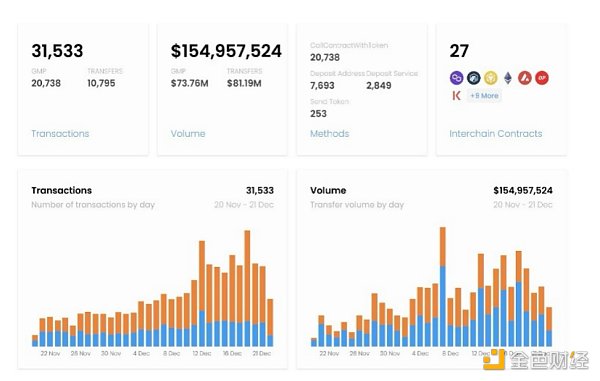
(10)LayerZero airdrop will draw attention to interoperability protocols
I admit that last reason may seem a bit contrived since my goal was to come up with a neat 10-item list, but it's worth noting that LayerZero and Wormhole's airdrops are expected to trigger Significant focus on cross-chain protocols.
LayerZero sparked excitement in the community earlier this month when it confirmed plans for an airdrop scheduled for the first half of 2024.
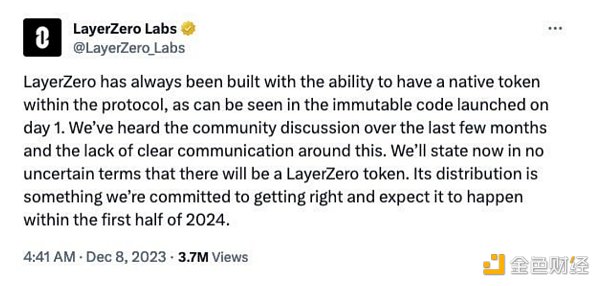
In addition, there is increasing speculation that Wormhole may airdrop and issue tokens. A February 2023 document detailed plans for a private token sale aimed at institutional investors. 750 million HOLE tokens were sold at a price of $0.25 per token, accounting for 7.5% of the total supply, raising approximately $187.5 million and valuing the project at $2.5 billion.
It is expected that these airdrops and token offerings will take place in 2024, which will greatly increase interest in cross-chain protocols. If both tokens trade above their private market valuations of $3 billion and $2.5 billion, respectively, it could prompt a reassessment of Axelar’s value, bringing it closer to its peers.
Cross-chain agreement due to its profitability nature, often being targeted by malicious actors. Common risks are loss of funds, unauthorized token minting, and fraudulent transactions. The root causes of these exploits vary from "rug pulling" and compromised bridge permissions to private key leaks and ownership takeovers.
Axelar faces similar security challenges that, while they can be minimized, can never be eradicated. Axelar uses a lock and mint (lock and mint) mechanism for token bridging. According to data from AxelScan, approximately $150 million is locked in Ethereum’s Axelar Gateway contract, a significant amount of money that could attract hackers.
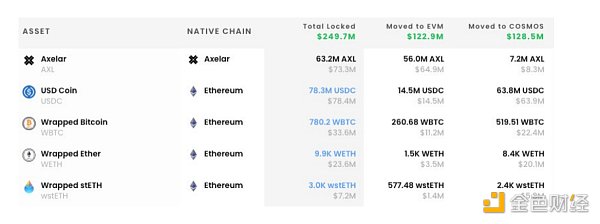
LlamaRisk emphasized in a security report in April that the Gateway contract can be upgraded through 4/8 multi-signature, which essentially The top is locking escrow of funds in Axelar and being able to impose transfer rate limits.
“4/8Multiple signatures control contract upgrades and can effectively keep the lock in Axelar’s funds. Additionally, it has the power to impose transfer rate limits.”
However, since June , Axelar has taken steps to promote a decentralized network by allowing sets of validators to jointly approve smart contract upgrades. This move addresses one of Axelar’s important security issues, which was mentioned in Uniswap’s bridging assessment report.
Think about the typical journey a new crypto user goes through today: First they buy on a centralized exchange (CEX) with a credit card or via bank transfer Stablecoins and then some tokens like SOL or ETH. Then they became interested in NFT and DeFi and wanted to try on-chain dapps. Now, wanting to withdraw money, they look at an intimidating online menu to choose from.
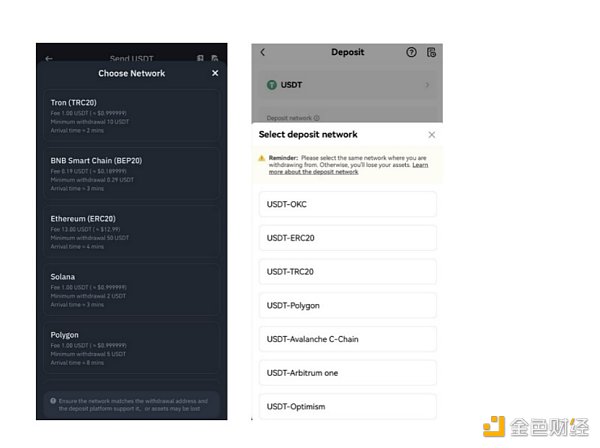
Expect them to be able to tell the difference between withdrawing USDT to TRON (cheap and fast, but no dapps) or Ethereum (expensive and slow, but best liquidity) or It's unrealistic that there are any subtle differences between zkSync (cheaper and faster Ethereum L2).
When it comes to assets such as SOL on CEXs such as Binance, the situation becomes more complicated. Users can withdraw SOL on the BNB chain. There is an additional complexity involved here, which is that SOL only exists natively on the Solana chain, while what they receive on the BNB chain is a wrapped version that is only recognized by the Binance exchange. This complexity can confuse newbies and confuse veterans.
Kyle from Multicoin Capital also expressed frustration with the confusion of multi-chain balance display, which is a common interface for most wallets today.
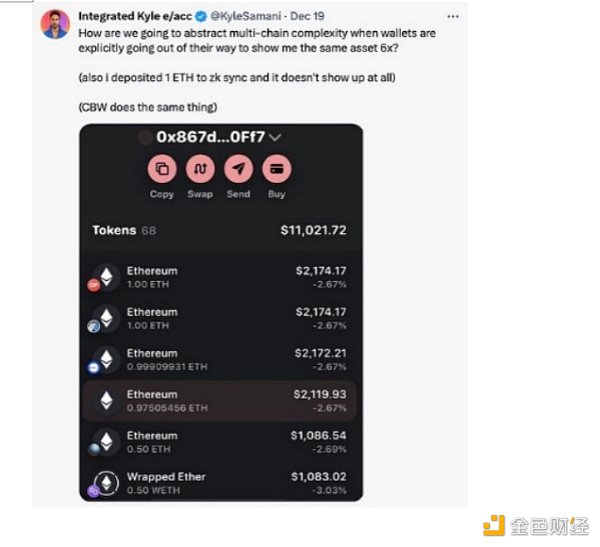
This complexity stems from the fact that the chain hosting the token is still important. The user interface remains complex because the underlying liquidity is fragmented and application logic is siled across chains. This situation is unlikely to change until there are truly cross-chain dApps powered by cross-chain AMP.
Now, imagine another future powered by cross-chain wallets built on Axelar. In such a future, users of centralized exchanges can withdraw any token through Axelar. In a universal wallet, balances are unified; differences between ETH on six different chains become irrelevant. Users interact with ETH on a chain, and when they deposit into a yield vault like Sommelier, they only maintain a single balance and position. Behind the scenes, yield protocols use Axelar to deposit their ETH into the most profitable pools or vaults on each chain.
This cross-chain future simplifies the user experience, unifies decentralized liquidity, and fully leverages the potential of decentralized finance, marking the beginning of blockchain A major leap forward in usability. This is the future of web3 that I am eagerly looking forward to.
虽然 DeSci 可能不会彻底改变整个科学生态系统,但它可以逐步通过发现其价值的研究人员和用户来扩展。最终,我们可能会看到 TradSci 和 DeSci 之间的平衡。
 JinseFinance
JinseFinanceGeorgios Vlachos, co-founder of Axelar Protocol and director of Axelar Foundation, said that tokenized AI agents will drive a new era of decentralized innovation, and their autonomy depends on the infrastructure we build today.
 JinseFinance
JinseFinanceFractal Bitcoin is an innovative blockchain expansion solution based on recursive virtualization technology that enhances Bitcoin's scalability by creating a multi-layer network structure while maintaining a secure connection to the main network.
 JinseFinance
JinseFinanceWhat exactly is RWA (real world asset tokenization)? Is RWA a product or a transaction?
 JinseFinance
JinseFinance“Interoperability is the future” — Vitalik Buterin.
 JinseFinance
JinseFinanceEurozone inflation has shown a slight decline, prompting speculation about the European Central Bank's (ECB) potential rate-cutting measures. Factors such as early Easter expenses and oil price increases contribute to this trend. While some countries report softer inflation numbers, indicating less price pressure, economic confidence in the Eurozone is showing signs of improvement. Divergent opinions within the ECB regarding rate reduction add complexity to the decision-making process. As the ECB's next meeting approaches, the debate continues: to cut rates or not. Overall, uncertainty surrounds Eurozone inflation, challenging the ECB to navigate conflicting viewpoints.
 Cheng Yuan
Cheng YuanThe Base network, supported by Coinbase, has experienced a surge in activity, particularly in memecoin trading. Transactions and trading volumes have reached record highs, with over 2.3 million transactions on March 30 alone. Decentralized exchanges on Base have seen unprecedented volumes, led by UniSwap. Memecoins have played a significant role in driving this surge, with speculation that Base could become a hub for such coins. However, this growth has also led to a significant increase in gas fees on the network. As Base continues to grow, sustaining its momentum will be crucial for its future success.
 Cheng Yuan
Cheng YuanOpenAI partners with Axel Springer to integrate AI into journalism, aiming to enhance news access and accuracy while navigating challenges of misinformation and the need for human oversight.
 YouQuan
YouQuanOpenAI and Axel Springer pioneer AI-driven journalism, offering users summaries of premium content. Challenges include public skepticism about AI's role in misinformation, necessitating ongoing scrutiny and human oversight.
 Xu Lin
Xu LinSome stablecoins have failed to deliver the dollar's stability to crypto traders long before TerraUSD's collapse.
 Cointelegraph
Cointelegraph